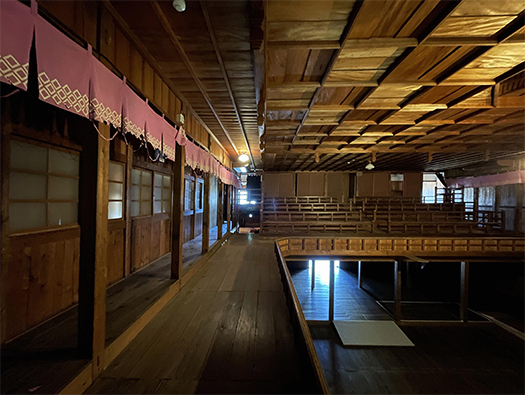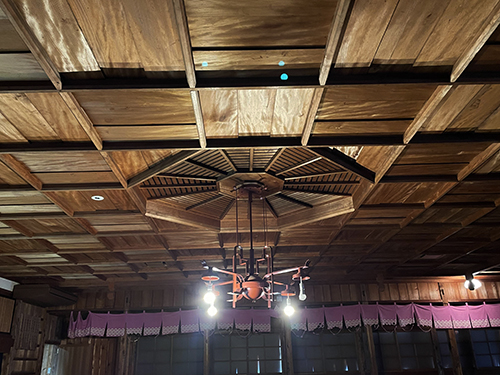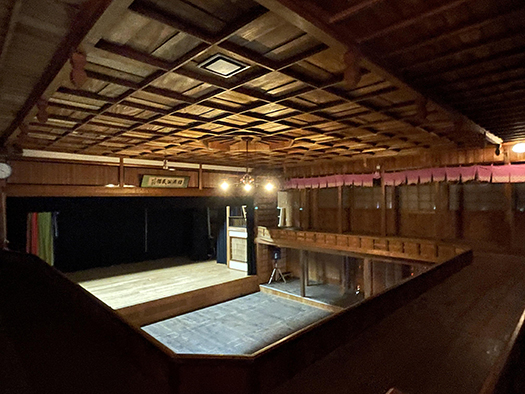


〜隈研吾と梼原町を結びつけたのは、木造の芝居小屋「ゆすはら座(梼原公民館)」。大正時代に流行した和洋折衷様式の流れを汲む貴重な建物だったが、建築から約40年を経た頃、老朽化などを理由に取り壊しが検討されていた。その保存運動に関わっていた高知県在住の一級建築士・小谷匡宏さんが、交流のあった隈さんに「ぜひゆすはら座を見てほしい」と依頼。隈さんは1987年(昭和62)に梼原町を訪ねたのだという。
この正直な木組みそのままの端正な美しさとそれを成し得た技術に圧倒された隈研吾は、ゆすはら座の保存運動に力を貸すことを決意。そして、それまでに手がけてきた装飾的なモダン建築の対極にあるようなこの建物との出会いは、建築家人生の大きな転機となった。隈建築の特徴である「木」へのこだわりは、ここから始まった。〜<昨日紹介の四国電力広報誌から要旨を引用。>
こうした木造の大型芝居小屋建築は全国で遺っている。架構はされていない野外建築だけれど川崎の日本民家園でも残されているし、四国香川県の四国村でも保存されている。また屋根も掛けられた秋田県鹿角郡小坂町にある小坂町立の芝居小屋「康楽館」はわたしも実見した。国の重要文化財。
娯楽の少ない時代、旅回りの芝居劇団がこういった小屋で公演することは、そのまま地域の貴重な一体感を確認する装置でもあったことだろう。やがてテレビに情報と娯楽の中心が移っていくことで、こうした建築施設はその主要な機能を失っていく。
しかし隈研吾が揺り動かされたように、村人全部を包含するような大きさとその木造の力強い架構ぶりからは、地域のプライドの象徴といった側面が強く感じられる。そして木肌のゆたかな表情からは、コンクリートや鉄筋などでは感受できないイキモノ感が強く伝わってくる。モダン建築に限界を感じていた隈研吾が、時間が経過した分だけ正直にその美感を訴えてくる建築と出会ったときに、コアが揺さぶられたものがあったのでしょう。


逆にこの「ゆすはら座」のような建築が、現代都市への人口集中、合理化最優先の社会構造の中で、人びとの「心の叫び」のようにして保存運動が盛り上がることに建築家として接して、木の魅力の復元再生がむしろ現代世界の閉塞性を突破できるものと直感したとも言えるのだろうか。
わたし的にはこの四国山地のド真ん中、清流・四万十川源流域と言われる梼原がむしろそのことを、現代社会の中で最大のセールスポイントとして訴求していったことが魅力的だと思う。むしろ地域戦略としてかなりパワーのある選択だと思えるのですね。
翻って全国でいま、木造の公共建築が大きく着手されてきている。これまでのコンクリートによる集約化・巨大化追究から潮目が大きく変化してきている。ゆすはら座は、そういう潮目で大きな役割を果たしているのかも知れない。
English version⬇
The richness of Yusuharaza, a theater building in Yusuhara, Shikoku, and Kengo Kuma-2
In response to the trend of population concentration, urbanization, and depopulation of rural areas, wooden architecture is sending a message through the persona of Kengo Kuma. Yusuhara, Shikoku
〜What brought Kengo Kuma and Yusuhara together was the Yusuhara Theater (Yusuhara Community Center), a wooden playhouse. It was a valuable building in the style of the Japanese-Western fusion that was popular in the Taisho era (1912-1926), but about 40 years after its construction, it was being considered for demolition due to aging and other reasons. Masahiro Kotani, a first-class architect living in Kochi Prefecture who was involved in the preservation movement, asked Mr. Kuma, with whom he had been in contact, to take a look at the Yusuhara-za. Mr. Kuma visited Yusuhara in 1987.
Overwhelmed by the neat beauty of this honest wooden structure as it was and the technology that enabled him to achieve it, Kuma Kengo decided to help in the campaign to preserve the Yusuhara-za. His encounter with this building, which was the polar opposite of the decorative modern architecture he had been working on, was a major turning point in his life as an architect. This was the beginning of Kuma’s obsession with wood, a characteristic of his architecture. Such large wooden playhouse buildings can be found all over Japan. Although it is an open-air structure with no structure, it has been preserved at the Nippon Minka-en in Kawasaki and at Shikoku-mura in Kagawa Prefecture, Shikoku. I also visited the Korakukan, a playhouse in Kosaka-cho, Kazuno County, Akita Prefecture, which is also covered with a roof. It is a national important cultural property.
In an era when entertainment was scarce, traveling theatrical troupes would have used performances at such a hut as a device for confirming the precious sense of unity in the community. Eventually, as the center of information and entertainment shifted to television, these architectural facilities lost their primary function.
However, as Kengo Kuma was moved by the building’s size, which seemed to encompass the entire village, and its powerful wooden structure, one can strongly sense the symbolic aspect of regional pride. The rich expression of the wood surface strongly conveys a sense of “real thing” that concrete and reinforced concrete cannot convey. Kengo Kuma, who felt the limitations of modern architecture, must have been shaken to the core when he encountered an architecture that honestly expressed its sense of beauty only through the passage of time.
Conversely, as an architect, I have seen the movement for the preservation of buildings such as Yusuharaza gain momentum as if it were a cry from people’s hearts in the midst of a social structure that places the highest priority on population concentration and rationalization in modern urban areas.
I think it is fascinating that Yusuhara, which is located in the middle of the Shikoku mountainous region and the headwaters of the clear Shimanto River, has made this its biggest selling point in the modern world. I think it is a rather powerful choice as a regional strategy.
On the flip side, there is now a major push for public buildings made of wood throughout Japan. The tide is turning away from the conventional pursuit of concrete construction, which has led to intensification and gigantic buildings. Yusuhara-za may be playing a major role in this trend.
Posted on 3月 25th, 2023 by 三木 奎吾
Filed under: 住宅マーケティング, 日本社会・文化研究







コメントを投稿
「※誹謗中傷や、悪意のある書き込み、営利目的などのコメントを防ぐために、投稿された全てのコメントは一時的に保留されますのでご了承ください。」
You must be logged in to post a comment.